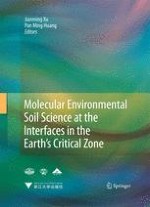2010 | OriginalPaper | Buchkapitel
Organic Fertility of Severely Eroded Soils: Effect of Organic and Inorganic Fertilization and Cropping Patterns
verfasst von : Wiqar Ahmad, Farmanullah Khan, Muhammad Naeem
Erschienen in: Molecular Environmental Soil Science at the Interfaces in the Earth’s Critical Zone
Verlag: Springer Berlin Heidelberg
Aktivieren Sie unsere intelligente Suche, um passende Fachinhalte oder Patente zu finden.
Wählen Sie Textabschnitte aus um mit Künstlicher Intelligenz passenden Patente zu finden. powered by
Markieren Sie Textabschnitte, um KI-gestützt weitere passende Inhalte zu finden. powered by
A study was conducted on farmer’s field for the restoration of fertility status of severely eroded soils in north west Pakistan during 2006 and 2007. Two factors viz fertilizer treatments included T1 (control), T2 (50% NP also called farmer’s practice), T3 (100% NPK) and T4 (20 t·ha
−1
farmyard manure integrated with 50% N and 100% PK as mineral fertilizers) whereas cropping patterns included C1 (maize-wheat-maize rotation), C2 (maizelentil-maize rotation) and C3 (maize-wheat+lentil intercrop-maize rotation). Experiment was started in Kharif 2006 and was carried out continuously for four seasons till Rabi 2007. At the end of the experiment, soil samples were collected from the surface (0∼20 cm) soil and analyzed for total N, microbial biomass N (MBN), mineralizable N, Organic matter (OM), microbial biomass C (MBC) at day 3, day 6 and day 10 incubation periods. Results suggested that the organic fertility of soil was significantly increased with fertilizer addition and the highest soil organic fertility was found in the treatment that received organic and inorganic fertilizers in integration (T4) which showed 52%, 14%, 17%, 60%, 56%, 57% and 60% increase in total N, mineralizable N, MNB, OM, MBC at day3, day 6 and day 10 over the control treatment respectively. Cropping patterns also affected soil organic fertility where cereal-legume rotation showed 21%, 13%, 6%, 17%, 21%, 22% and 13% increase in the above parameters and time. Fertilizers must be applied in integrated form which carries 50% N from inorganic source and the rest of 50% from organic sources to improve the level of organic fertility of eroded soils on sustained basis. Results further suggested that legumes must be entered into conventional cereal-cereal rotation to improve the N input and organic fertility of severely eroded soils.
